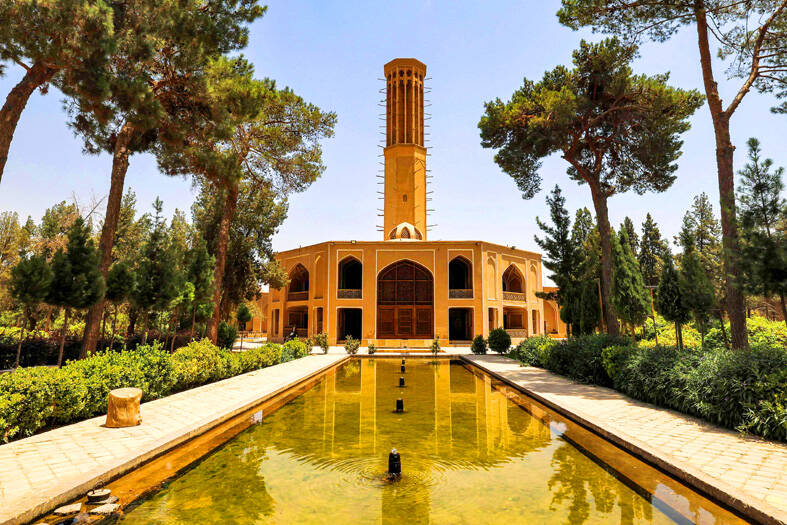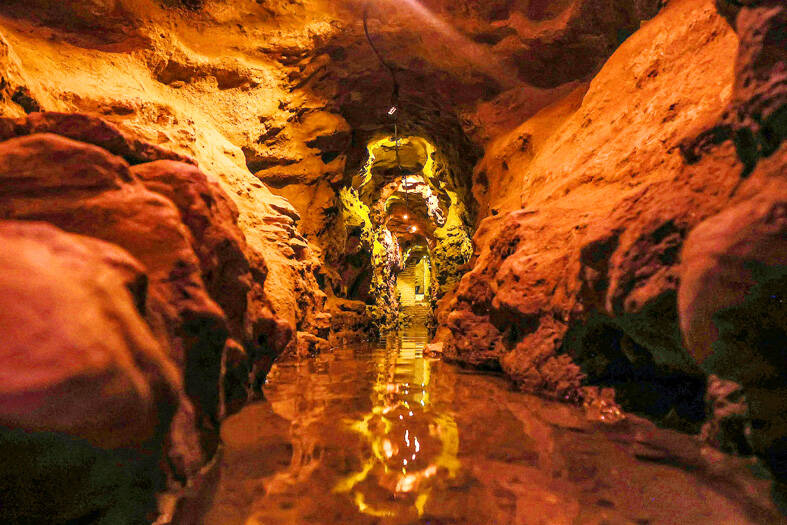Tall, chimney-like towers rise from centuries-old adobe houses in Iran’s desert city of Yazd, drawing in a pleasant breeze for residents of one of the hottest cities on earth. The windcatchers, called badgir in Persian, are just one of the engineering marvels inhabitants have developed in this ancient city where temperatures reach well above 40°C in the summer. And, unlike energy-guzzling air conditioners, they are cost and carbon-free.
“For centuries, before we had electricity, they made it possible to cool dwellings,” said Abdolmajid Shakeri, the provincial deputy of Iran’s Ministry of Cultural Heritage, Handicrafts and Tourism.
The oldest of the city’s 700 windcatcher dates back to the 14th century, but the architectural feature is believed to date back as far as 2,500 years when the Persian Empire ruled over much of the Middle East.

Photo: AFP
“The badgirs played a key role in the city’s prosperity,” Shakeri said about the desert city that was a caravan stop on the ancient Silk Road.
“Thanks to them, people lived at ease,” he added, describing how the windcatchers pull fresh air into buildings and allow hot air to ventilate out through large vertical slots.
Majid Oloumi, the head of Dowlat Abad Garden, home to a towering 33.8m windcatcher — one of the tallest in the world — described the cooling method as “totally clean, because it uses neither electricity nor polluting materials.”

Photo: AFP
UNESCO listed Yazd as a World Heritage Site in 2017, describing the city as a “living testimony to intelligent use of limited available resources in the desert for survival.”
The bioclimatic architecture that provides thermal comfort for the people of Yazd has attracted interest elsewhere on a heating planet.
“Badgirs demonstrate that simplicity can be an essential attribute to sustainability,” said Paris-based architect Roland Dehghan Kamaraji, who has studied Iran’s windcatcher. “It goes against the common misconception that sustainable solutions need to be complex or high-tech.”
At a sustainable urban community called Masdar city in the United Arab Emirates, buildings have been “designed to make use of the natural ventilation for cooling, like badgirs,” he said.
Similarly, ventilation inspired by “termite mounds, an approach similar to that of badgirs,” was built atop Eastgate Center, a shopping mall and office complex in Harare, Zimbabwe.
However, Yazd’s unique architectural traditions have largely been abandoned at their birthplace.
“Unfortunately, our ancestral heritage has been forgotten,” especially since the emergence of air conditioners, Oloumi said.
Yazd’s old town is a labyrinth of narrow streets and roofed alleyways. Its centuries-old edifices made of clay, mud-brick and adobe all provide insulation against the torrid heat. However, the old houses stand in sharp contrast to modern cement buildings and multi-lane roads.
“Today, house architecture imitates that in other countries, and cement-based construction does not correspond to the climate of Yazd,” he added.
Kamaraji said bioclimatic architecture has waned due to economic constraints and modern construction methods that “largely favor the use of energy and fossil fuel intensive materials.”
Another sustainable architectural feature of Yazd is its system of underground aqueducts called qanats, which transport water from underground wells, aquifers or the mountains.
“These underground aqueducts have great utility,” said Zohreh Montazer, an expert on the water system. “They constitute a source of water supply and make it possible to cool the dwellings and to preserve food at an ideal temperature.”
Iran is estimated to have about 33,000 operational qanats today, a significant drop from the 50,000 in use in the mid-20th century.
UNESCO says the decline in qanats is driven in part by the drying up of underground water sources due to overconsumption.
Iranian authorities have in recent years sought to rehabilitate the qanat of Zarch — considered the longest and oldest, dating about 3,000 years ago.
The water network — which stretches more than 70km across Yazd and runs at a depth of about 30m — stands as a reminder for Yazd’s residents of the challenges ahead.
“The day when fossil fuels run out, we will have to return to these methods,” Montazer said.

Incumbent Ecuadoran President Daniel Noboa on Sunday claimed a runaway victory in the nation’s presidential election, after voters endorsed the young leader’s “iron fist” approach to rampant cartel violence. With more than 90 percent of the votes counted, the National Election Council said Noboa had an unassailable 12-point lead over his leftist rival Luisa Gonzalez. Official results showed Noboa with 56 percent of the vote, against Gonzalez’s 44 percent — a far bigger winning margin than expected after a virtual tie in the first round. Speaking to jubilant supporters in his hometown of Olon, the 37-year-old president claimed a “historic victory.” “A huge hug

Two Belgian teenagers on Tuesday were charged with wildlife piracy after they were found with thousands of ants packed in test tubes in what Kenyan authorities said was part of a trend in trafficking smaller and lesser-known species. Lornoy David and Seppe Lodewijckx, two 19-year-olds who were arrested on April 5 with 5,000 ants at a guest house, appeared distraught during their appearance before a magistrate in Nairobi and were comforted in the courtroom by relatives. They told the magistrate that they were collecting the ants for fun and did not know that it was illegal. In a separate criminal case, Kenyan Dennis

A judge in Bangladesh issued an arrest warrant for the British member of parliament and former British economic secretary to the treasury Tulip Siddiq, who is a niece of former Bangladeshi prime minister Sheikh Hasina, who was ousted in August last year in a mass uprising that ended her 15-year rule. The Bangladeshi Anti-Corruption Commission has been investigating allegations against Siddiq that she and her family members, including Hasina, illegally received land in a state-owned township project near Dhaka, the capital. Senior Special Judge of Dhaka Metropolitan Zakir Hossain passed the order on Sunday, after considering charges in three separate cases filed

APPORTIONING BLAME: The US president said that there were ‘millions of people dead because of three people’ — Vladimir Putin, Joe Biden and Volodymyr Zelenskiy US President Donald Trump on Monday resumed his attempts to blame Ukrainian President Volodymyr Zelenskiy for Russia’s invasion, falsely accusing him of responsibility for “millions” of deaths. Trump — who had a blazing public row in the Oval Office with Zelenskiy six weeks ago — said the Ukranian shared the blame with Russian President Vladimir Putin, who ordered the February 2022 invasion, and then-US president Joe Biden. Trump told reporters that there were “millions of people dead because of three people.” “Let’s say Putin No. 1, but let’s say Biden, who had no idea what the hell he was doing, No. 2, and